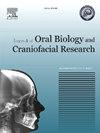Research progress of hydrogel therapy to improve hypoxic environment of periodontal tissues and promote periodontal regeneration
Q1 Medicine
Journal of oral biology and craniofacial research
Pub Date : 2025-06-13
DOI:10.1016/j.jobcr.2025.06.005
引用次数: 0
Abstract
Periodontitis is a hypoxic infectious disease. When periodontal tissues are affected by disease and the microenvironment becomes inflamed, the release of local inflammatory factors and increased tissue metabolism lead to an imbalance between oxygen supply and demand. This inflammatory environment disrupts blood microcirculation, causing the local periodontal tissue to enter a relatively ischemic and hypoxic state. Deep periodontal pockets and periodontal pathogenic bacteria further reduce the oxygen tension in periodontal tissues, exacerbating the progression of periodontitis. Current treatment strategies for improving the inflammatory microenvironment include mechanical therapy and systemic or localized antibiotic administration. However, these existing methods fail to effectively restore the microbiota balance, ensure sustained drug release, or maintain drug presence at the lesion site. Hydrogels, due to their low cytotoxicity, excellent water retention properties, and ability to control drug release, serve as an effective drug delivery pathway that supplies oxygen to inflammatory sites. This article reviews the mechanisms and recent advancements in using hydrogel-based therapies to improve the hypoxic microenvironment of periodontal tissues, thereby promoting periodontal regeneration, and provides clinical insights for future applications in periodontal regeneration.
水凝胶治疗改善牙周组织缺氧环境促进牙周再生的研究进展
牙周炎是一种缺氧感染性疾病。当牙周组织受到疾病影响,微环境发生炎症时,局部炎症因子的释放和组织代谢的增加导致氧供需失衡。这种炎症环境破坏血液微循环,导致局部牙周组织进入相对缺血和缺氧状态。深层牙周袋和牙周致病菌进一步降低了牙周组织的氧张力,加剧了牙周炎的发展。目前改善炎症微环境的治疗策略包括机械治疗和全身或局部抗生素治疗。然而,这些现有的方法不能有效地恢复微生物群平衡,确保持续的药物释放,或维持药物在病变部位的存在。水凝胶由于其低细胞毒性、优异的保水性和控制药物释放的能力,可以作为一种有效的药物传递途径,为炎症部位提供氧气。本文综述了水凝胶治疗改善牙周组织缺氧微环境,促进牙周再生的机制和最新进展,并为未来在牙周再生中的应用提供了临床见解。
本文章由计算机程序翻译,如有差异,请以英文原文为准。
求助全文
约1分钟内获得全文
求助全文
来源期刊

Journal of oral biology and craniofacial research
Medicine-Otorhinolaryngology
CiteScore
4.90
自引率
0.00%
发文量
133
审稿时长
167 days
期刊介绍:
Journal of Oral Biology and Craniofacial Research (JOBCR)is the official journal of the Craniofacial Research Foundation (CRF). The journal aims to provide a common platform for both clinical and translational research and to promote interdisciplinary sciences in craniofacial region. JOBCR publishes content that includes diseases, injuries and defects in the head, neck, face, jaws and the hard and soft tissues of the mouth and jaws and face region; diagnosis and medical management of diseases specific to the orofacial tissues and of oral manifestations of systemic diseases; studies on identifying populations at risk of oral disease or in need of specific care, and comparing regional, environmental, social, and access similarities and differences in dental care between populations; diseases of the mouth and related structures like salivary glands, temporomandibular joints, facial muscles and perioral skin; biomedical engineering, tissue engineering and stem cells. The journal publishes reviews, commentaries, peer-reviewed original research articles, short communication, and case reports.
 求助内容:
求助内容: 应助结果提醒方式:
应助结果提醒方式:


